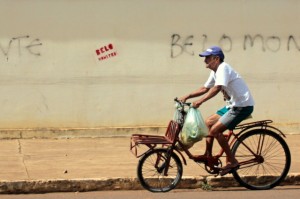 Opposition against the construction of the Belo Monte dam on Xingu River in the Amazon has reached a new high as protesters have invaded the building site this week. Forbes magazine has deemed the project “the most hated government project in the world.â€
Opposition against the construction of the Belo Monte dam on Xingu River in the Amazon has reached a new high as protesters have invaded the building site this week. Forbes magazine has deemed the project “the most hated government project in the world.â€
On Wednesday a group of fisherman and indigenous people from the Xingu Vivo movement disrupted the initial works on ‘coffer dams’ (temporary dams), displaying banners that said: Belo Monte: crime of the Federal Government. They managed to disrupt the works for two hours.
Yesterday the office buildings of the Belo Monte consortium in Altamira, the town where the project is headquartered, woke up with graffiti expressing opposition to the project. Other buildings related to the project were also targeted, as well as banks and several public and commercial offices. The slogans said “Death Energyâ€, “Belo Monsterâ€, “Belo Death†and “Wounded Xinguâ€.
Opposition to the project is widespread both in Brazil and abroad. The anti-Belo Monte activists have attracted support from celebrities such as Avatar director James Cameron and film star Sigourney Weaver, to name but a few.
You should follow us here.






The World Bank estimates that forcible “development-induced displacement and resettlement†now affects 10 million people per year. According to the World Bank an estimated 33 million people have been displaced by development projects such as dams, urban development and irrigation canals in India alone.
India is well ahead in this respect. A country with as many as over 3600 large dams within its belt can never be the exceptional case regarding displacement. The number of development induced displacement is higher than the conflict induced displacement in India. According to Bogumil Terminski an estimated more than 10 million people have been displaced by development each year.
Athough the exact number of development-induced displaced people (DIDPs) is difficult to know, estimates are that in the last decade 90–100 million people have been displaced by urban, irrigation and power projects alone, with the number of people displaced by urban development becoming greater than those displaced by large infrastructure projects (such as dams). DIDPs outnumber refugees, with the added problem that their plight is often more concealed.
This is what experts have termed “development-induced displacement.†According to Michael Cernea, a World Bank analyst, the causes of development-induced displacement include water supply (dams, reservoirs, irrigation); urban infrastructure; transportation (roads, highways, canals); energy (mining, power plants, oil exploration and extraction, pipelines); agricultural expansion; parks and forest reserves; and population redistribution schemes.